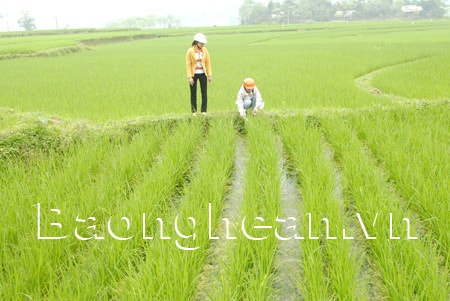Que Phong replicates the model of deep fertilization
(Baonghean) - After a year of using deep-planted fertilizer, the ethnic people of Que Phong district have seen much higher rice yields than with previous broadcast fertilizer applications. This spring, the district has a policy of continuing to support the expansion of the model...
Mr. Trinh Xuan Dung, Head of the District Agriculture Department, said: Comparing the effectiveness of deep fertilization with broadcast fertilization in the spring crop last year, it shows that for 1 hectare of rice, if fertilized with deep fertilization, it takes 250 kg multiplied by the price of 13.5 thousand VND/kg = 3,375 VND; for broadcast fertilization, it requires 500 kg of NPK multiplied by the price of 6.2 thousand VND/kg = 3,100 VND. But the yield of the area fertilized with deep fertilization is on average 57 quintals/ha, while the average yield of broadcast fertilization is 43 quintals/ha. Thus, the investment in deep fertilization is slightly higher than that of broadcast fertilization, but the yield of deep fertilization is much higher than that of broadcast fertilization. Obviously, using deep fertilization is more economically efficient, and more importantly, using deep fertilization prevents soil erosion, which is very suitable for rice production on terraced fields.
Spring rice fields in Chau Kim commune that apply deep fertilizer all grow well.
Realizing the effectiveness, this year Que Phong continues to use the capital of the Government's Program 30a, 102 to support farmers to invest in buying bamboo rat fertilizer for 1,000 hectares of spring rice (last spring crop Que Phong used bamboo rat fertilizer for 570 hectares). To promptly supply enough bamboo rat fertilizer for farmers, Que Phong district assigned 2 specialized agricultural service cooperatives to produce it, namely Quang Truong Cooperative, Tien Phong commune and Chau Kim Cooperative.
Mr. Ha Van Hoa, a farmer in Do village, Chau Kim commune, boasted: His family has 3 sao of rice fields. Last year, he applied manure fertilizer to 2 sao and saw that the rice yield was much higher than previous years. This spring, his family applied manure fertilizer to all 3 sao of rice fields. Up to this point, the rice plants have grown well. According to our observations in the fields of Do village, the rice plants grown much better in the fields fertilized with manure than in the fields fertilized with broadcast fertilizer. And the fields fertilized with manure apply the method of planting in wide and narrow rows to facilitate fertilization.
Ms. Vi Thi Thuy, Chairman of Chau Kim Commune People's Committee, said: This spring crop, the locality planted 197.3 hectares of rice. The characteristic of the cultivated land here is terraced fields, so applying dung fertilizer is very effective. Therefore, this spring crop, farmers in the commune applied dung fertilizer on an area of 70 hectares (last spring crop applied dung fertilizer on 65 hectares). This spring crop, farmers should have applied dung fertilizer on a much higher area than the previous crop, but because the amount of dung fertilizer produced by Chau Kim Agricultural Cooperative had to supply models in other communes, it was not enough to meet the demand.
Deep-burying fertilizer is a combination of two types of fertilizer: nitrogen and potassium mixed together, using a machine to press into pellets the size of plum seeds. After planting the rice, farmers bring the fertilizer pellets deep into the roots of the rice plants. During the rice growth process, the fertilizer also dissolves, creating conditions for the rice roots to absorb. And even though there is heavy rain, the fertilizer will not be washed away like broadcast fertilizer. Applying deep-burying fertilizer is very favorable for rice production on terraced fields, so mountainous districts need to apply and replicate this model.
Xuan Hoang
